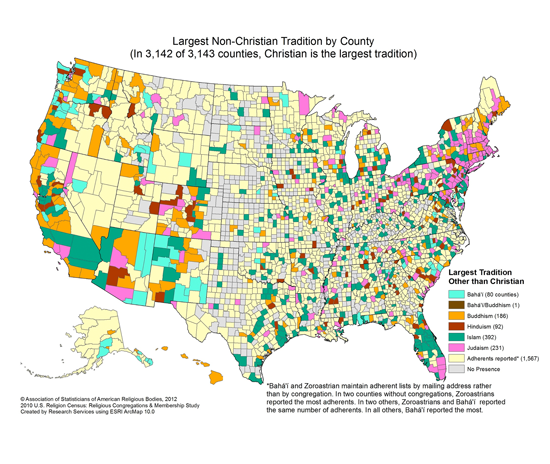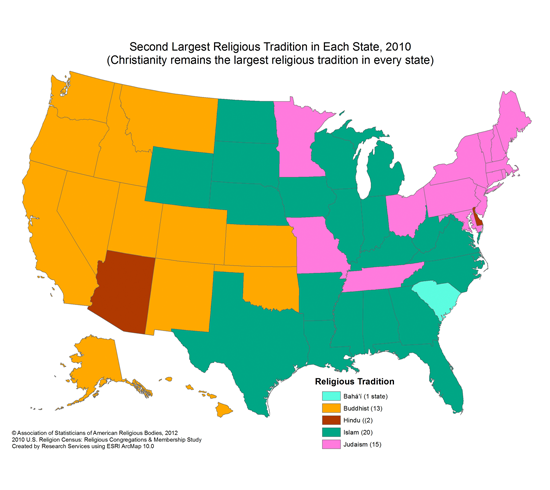Scholars have known for some time that Buddhism is the largest religion in Hawaii after Christianity, the majority religion in all US states. Now—according to an article in last week’s Washington Post—Buddhism has also attained second-place status in a dozen Western states.
The Washington Post makes its case with a colorful map that indicates the number of adherents to the second-largest religion in each state. It shows Buddhism taking second-place honors in Hawaii, Alaska, Washington, Oregon, California, Idaho, Montana, Nevada, Utah, Colorado, New Mexico, Kansas, and Oklahoma.
When you look at the map by county, however, the data isn’t as clear as the first state-by-state map suggests. The solid swath of Buddhist saffron that covers nearly the entire western side of America in the state map becomes a fractured mess of color in the county map. It reveals that Buddhism is sometimes only popular in a handful of the Western states’ small counties, with many other surrounding counties colored to indicate that Muslims, Jews, Hindus, or Baha’i are the dominant minority. Buddhists dominate only a single county in both Nevada and Oklahoma, for example, but because those counties are so populous, the whole state gets awarded to the Buddhists. The opposite also happens: there are places where Buddhists are clearly numerous, yet the state is claimed for some other religion. (The informative value of these kinds of maps in general was recently critiqued in an article in Jacobin titled “Infotainment Journalism.”)

My reaction to these maps, especially the primary state-by-state one, is conflicted. The data on Buddhism may be broadly correct, but a closer look reveals many flaws. The Religious Congregations and Membership Study, which provides the data for these maps, pulls its statistics on Buddhism from a significant but problematic study conducted in 2009. I was present when the results of that study were announced at the American Academy of Religion, and like many other experts, I came away troubled by the conceptual flaws in the data collection. My own understanding of the numbers, based on field site visits to many hundreds of Buddhist groups in every tradition and every part of America, differed significantly from theirs. Some groups I knew to be much smaller than they were being represented, while others were certainly larger than the study claimed. And there were some key groups that seemed to be flat out missing. I happened to be seated next to a high-ranking insider for one of the (allegedly) biggest groups included in the study, and as the number of adherents in his organization was rattled off by the presenter, he sharply drew in his breath, shook his head, and turned to whisper to me that the study’s number was way off: his group had at best a third of the number of members that the study was claiming.
Why is it so hard to get the numbers right on Buddhists in America, despite the best efforts of highly trained and experienced social scientists? To save space (and the reader’s patience), I’ll just focus on the largest factors that cause under- and overestimation of Buddhist populations in the US. The data for the maps is based on a study that counted affiliations with organized religious groups—a method, like nearly all studies of American religion, derived from a Protestant Christian model. This model fundamentally assumes that all religious persons gather together into exclusive public bodies with which they maintain a unique personal identification. But that just isn’t true of most religions, and it certainly isn’t true for most people who practice Buddhism, in Asia or in the United States.
For the average Buddhist practitioner, there has never been an expectation of regular visitation to a site like Sunday morning church service. Nor has there been an expectation of formal membership in a specific group, such as belonging to a congregation. The average person in Buddhist Asia hasn’t claimed personal identification with a particular sect—indeed, in many cultures historically influenced by Buddhism, regular participants in Buddhist activities won’t even admit to belonging to any religion, let alone claiming identity as a Buddhist.
The Buddhist pattern of non-attendance and non-affiliation holds fairly well in the United States, too. Here, religious incorporation laws based on Protestant congregationalism and dominant cultural expectations have led some Buddhists to create formal institutions that hold weekly meetings and maintain membership lists (or at least mailing lists). But the simple fact is that great masses of people practicing Buddhism—including self-identified Buddhists— don’t profess affiliation with any particular institution. This means that even generally reliable data collection methods, such as large-scale phone surveys that ask individuals to list their religious identifications, do not capture a fully accurate picture of Buddhist numbers.
When you collect data by contacting Buddhist groups in the phonebook (so to speak—the study’s attempts to identify formal Buddhist groups were actually more wide-ranging and sophisticated), you miss crucial pieces of the puzzle. Not only do you neglect the sizable numbers of people who rarely or never attend a public group; you also overlook the many grassroots gatherings and loose networks that aren’t registered as formal tax-exempt organizations. These missing Buddhists almost certainly comprise the majority of people practicing Buddhism in America. So at the very best, these maps represent the relative sizes of minority religious institutions in each state rather than the actual relative number of Buddhists, Muslims, and so forth.
On the other hand, approaching the groups you can find and asking them how many adherents they have is also a recipe for problems. Religious groups often have little incentive to report accurate numbers. Many lack the ability—or interest—to collect reliable data. Minority religious groups have even less incentive: when you’re heavily outnumbered in a historically racist and at times religiously intolerant society, you’ve got compelling reasons to exaggerate your size and strength. Projecting a larger image of small organizations can help dissuade those who might be inclined to harass those groups they think can’t fight back.
Among other things, projecting a larger image of your organization can make it seem less marginal. The issue is compounded by the sense of competition that many religious groups—including some Buddhists—feel with outside groups. Numbers come to be seen as a measure of the effectiveness, even the correctness, of one’s doctrines and practices. It can be embarrassing or humiliating to report the low number of people who agree with your conviction of how the universe operates. Many misrepresent their groups’ sizes as much to avoid their own anxieties as to brag to outsiders.
The numbers that the Washington Post maps utilize thus cannot be accurate in any strict sense of the word, since they’ve missed many Buddhists on the one hand and received dubious information from some of the groups on the other. But does this mean that the study, and the maps derived from it, are useless to us? Not necessarily so.
Although not completely accurate, the study is suggestive and intriguing. Leaving aside the specific numbers, we can focus on overall patterns. Regardless of whether or not Buddhism is indeed the second-largest religion in all 13 listed states—and none of the other 37—we can be relatively confident that Buddhism tends to represent a higher percentage of adherents compared to other non-Christian groups in the West than in other parts of the country.
In my book Dixie Dharma, I argue that we need to take a regional view in examining Buddhism in America, and the West is one of the most important of America’s Buddhist regions. Western states have received the highest share of Buddhist immigrants since the 1840s, and the region’s spirit of religious experimentation has encouraged many others to explore Buddhism. Buddhism on the Left Coast has had a long time to establish an institutional presence, and has also had a great mass of likely adherents from which to draw. It thus makes a good showing in a study based on a survey of religious institutions.
These differences between places, such as that between the West and the rest of America, give reason to take a regional lens rather than blithely talking about “American Buddhism” as a whole. To practice Buddhism in California may be a different thing than to practice it in South Carolina. Beyond the obvious differences of climate and terrain, the Buddhist experience is impacted by whether one has access to local institutions and a variety of traditions—something most Americans can’t take for granted. It matters if Buddhism is acknowledged as a relatively large presence in one’s area or exists among a variety of different minority religions and a significant population of non-religious (or at least non-committed) people. It’s quite a different Buddhist experience to practice in a place where religious diversity is low and not necessarily celebrated than in much of California.
Even if some survey one day suggests more reliably that Buddhism is the second-largest religion in every state, we’ll still need to keep these sorts of maps in perspective. The truth is that Christians outnumber members of non-Christian religions 15 to 1. And Christianity’s massive dominance is unlikely to change within our lifetimes or those of our grandchildren, no matter how multicultural the country becomes in the meantime. As sociologist Mark Silk points out in his own reaction to the Washington Post article, even the religiously unaffiliated outnumber all minority religions put together by a factor of 4 to 1. In light of this, being the second largest religion just doesn’t amount to much.
Further reading: The World is Places
Thank you for subscribing to Tricycle! As a nonprofit, we depend on readers like you to keep Buddhist teachings and practices widely available.
